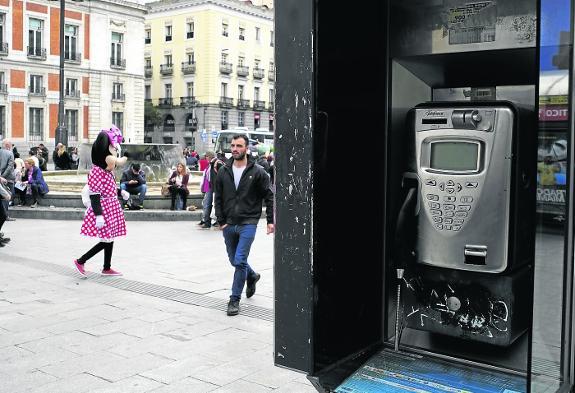

Sections
Highlight

SUSANA ZAMORA
Tuesday, 24 July 2018, 18:58
Compartir
Ana Cisneros took her mobile phone with her as usual when she left home that day. The battery was a bit low, but she thought it would last while she was out. Unfortunately, it didn't. When she picked it up to make an urgent call, it was dead, so she went to look for a public phone box.
That proved to be like looking for a needle in a haystack, and when she did eventually find one, it was a frustrating experience. The first one wasn't working; the next one swallowed all the money before she could speak to anybody; the third was out of order and finally she was able to make her call in the fourth one she found.
"We never think about them until we need them. I don't know what I would have done if I hadn't been able to make that call, that day," Ana says.
Even so, the days of these public phones could be numbered. The Spanish government doesn't want the obligation of maintaining phone booths or producing the directories, those bulky books that were once found in every home: in the 1990s, nearly 12 million directories were produced, but now there are only a few hundred.
This matter features in the recent modification to Royal Decree 424/2005. This document states that due to the present situation in the electronic communications sector "some universal telecommunications services are falling progressively into disuse."
The proposal from the Ministry of Energy, Tourism and Digital Agenda came after it obliged Telefónica to take charge of maintaining the phone boxes for two consecutive years, in 2017 and 2018, as the operator which has historically been dominant in the sector and because its competitors were refusing to take over the service.
This was bound to lead to their disappearance, given that the company, whose president is José María Álvarez-Pallete, says that two out of every three are no longer profitable. Without the obligation to keep them working, at least 12,000 of the 18,161 which still exist today would disappear in 2019. In the last decade around 5,000 phone boxes a year have been taken out of service.
One call a day
Sources at Telefónica admit that the service is "clearly deficient" and only exists due to "sentimental" reasons, nostalgia for an era that new technology is bringing to an end. However, the modification to the law still guarantees calls to directory enquiries for people who are sight-impaired, who are permitted ten connections a month free of charge.
The role of public phone boxes has been disputed for years. The first one in Spain was installed in 1928 in the Florida Park centre in El Retiro park in Madrid, and after that the number multiplied all over the country.
At the end of the 1990s, their golden age when they still worked with 25-peseta coins, there were over 100,000, but with the euro and the new millennium everything started to change, first because mobile phones became so popular, and then with the arrival of smartphones.
The National Commission for Markets and Competition has questioned the viability of public phone boxes on several occasions, partly for economic reasons, because it costs 2.7 million euros a year to maintain them, and also for social reasons because they are used less and less.
In December last year the Commission sent the government a report warning that the phones are no longer profitable because so many people use mobiles.
In the document, it said that 88 per cent of the population had never used a public phone box in their lives. In addition there is the fact that barely 22,000 calls a day are made from the 18,161 public phones in Spain; that works out at slightly more than one call from each.
However the General Law of Telecommunications, in its section on universal service, obliges the concession holder (in this case Telefónica) to have at least one public phone in operation in every village with fewer than 1,000 inhabitants, and then two for every 3,000 inhabitants. Telephone directories are now available online and are only provided to people who expressly request them. There are barely 100 such requests a year.
It looks, then, as if these relics from the last century, which for decades enabled millions of people without a phone at home to communicate, are condemned to disappear. Not everyone will be happy to see them go, because apart from a certain amount of nostalgia about them, some see them as essential.
"What are we supposed to do in an emergency if we don't have a mobile phone? We shouldn't rely on mobiles so much," says Ana Cisneros.
Publicidad
Publicidad
Publicidad
Publicidad
Reporta un error en esta noticia
Necesitas ser suscriptor para poder votar.